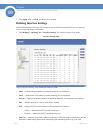
165
Chapter 10:
SFE2000/SFE2000P Gigabit Ethernet Switch Reference Guide
Chapter
10
– Alternate — Provides an alternate path to the root switch from the root interface.
– Backup — Provides a backup path to the designated port path toward the Spanning Tree
leaves. Backup ports occur only when two ports are connected in a loop by a point-to-point
link. Backup ports also occur when a LAN has two or more connections connected to a
shared segment.
– Disabled — Indicates the port is not participating in the Spanning Tree.
• Mode — Indicates the current Spanning Tree mode. The Spanning Tree mode is selected in the
Global STP page. The possible field values are:
– Classic STP — Indicates that Classic STP is enabled on the device.
– Rapid STP — Indicates that Rapid STP is enabled on the device.
– Multiple STP — Indicates that Multiple STP is enabled on the device.
• Fast Link — Indicates if Fast Link is enabled or disabled for the port or LAG. If Fast Link is enabled
for a port, the port is automatically placed in the forwarding state.
• Port Status — Indicates if RSTP is enabled on the interface. The possible field values are:
– Enable — Indicates that RSTP is enabled on the port.
– Disable — Indicates that RSTP is disabled on the port.
• Point-to-Point Operational Status — Indicates the Point-to-Point operating state.
• Activate Protocol Migration — Runs a Protocol Migration Test. The test sends Link Control
Protocol (LCP) packets to test if a data link is enabled.
2. Define the relevant fields.
3. Click Apply. The Rapid Spanning Tree Settings are defined, and the device is updated.
Modifying RTSP
1. Click Bridging > Spanning Tree > RSTP. The RSTP Page opens:
2. Click the Edit button. The Edit Rapid Spanning Tree Page opens:


















